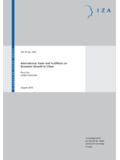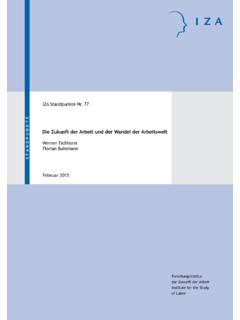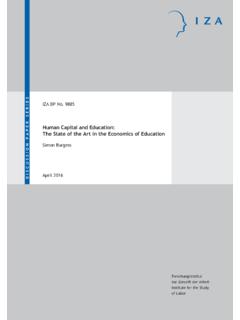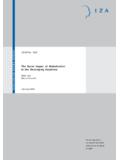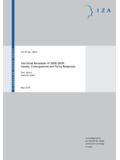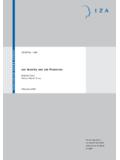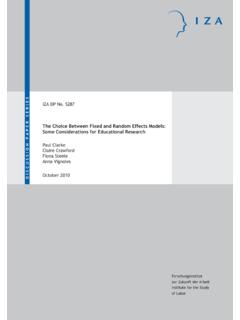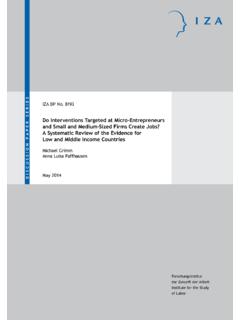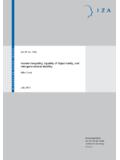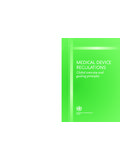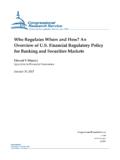Transcription of The International Migration of Health Professionals
1 SERIES. IZA DP No. 6517. PAPER. The International Migration of Health Professionals Michel Grignon DISCUSSION. Yaw Owusu Arthur Sweetman April 2012. Forschungsinstitut zur Zukunft der Arbeit Institute for the Study of Labor The International Migration of Health Professionals Michel Grignon McMaster University Yaw Owusu McMaster University Arthur Sweetman McMaster University and IZA. Discussion Paper No. 6517. April 2012. IZA. Box 7240. 53072 Bonn Germany Phone: +49-228-3894-0. Fax: +49-228-3894-180. E-mail: Any opinions expressed here are those of the author(s) and not those of IZA. Research published in this series may include views on policy, but the institute itself takes no institutional policy positions. The Institute for the Study of Labor (IZA) in Bonn is a local and virtual International research center and a place of communication between science, politics and business. IZA is an independent nonprofit organization supported by Deutsche Post Foundation. The center is associated with the University of Bonn and offers a stimulating research environment through its International network, workshops and conferences, data service, project support, research visits and doctoral program.
2 IZA engages in (i). original and internationally competitive research in all fields of labor economics, (ii) development of policy concepts, and (iii) dissemination of research results and concepts to the interested public. IZA Discussion Papers often represent preliminary work and are circulated to encourage discussion. Citation of such a paper should account for its provisional character. A revised version may be available directly from the author. IZA Discussion Paper No. 6517. April 2012. ABSTRACT. The International Migration of Health Professionals *. Health workforce shortages in developed countries are perceived to be central drivers of Health Professionals ' International Migration , one ramification being negative impacts on developing nations' healthcare delivery. After a descriptive International overview, selected economic issues are discussed for developed and developing countries. Health labour markets' unique characteristics imply great complexity in developed economies involving government intervention, licensure, regulation, and (quasi-)union activity.
3 These features affect migrants' decisions, economic integration, and impacts on the receiving nations' Health workforce and society. Developing countries sometimes educate citizens in expectation of emigration, while others pursue International treaties in attempts to manage migrant flows. JEL Classification: J61, I15, I18. Keywords: Migration , Health Professionals , International medical graduates Corresponding author: Arthur Sweetman Department of Economics McMaster University Hamilton, Ontario L8S 4M4. Canada E-mail: *. This paper is forthcoming as a chapter in the International Handbook on the Economics of Migration . We would like to thank the editors and an anonymous referee for helpful comments that have improved the manuscript. 1. INTRODUCTION. International Migration by Health Professionals is an area of increasing policy interest. Shortages of medical personnel in several developed countries are perceived to be central drivers of this phenomenon, and there are critical ramifications for developing countries ( , World Health Organization WHO, 2006).
4 After a period of perceived excess supply in many developed countries in the 1990s, more recent years have seen an increased demand for Health Professionals , a growing concern about the need to provide healthcare services to aging populations, and an increasing focus on Health human resources more generally. The International Migration Outlook (Organization for Economic Cooperation and Development OECD, 2007a) identifies "several International initiatives formulating policy recommendations to overcome the global Health workforce crisis" ( ).1 In response to these flows, in 2010 the WHO adopted a global code of practice on the International recruitment of Health personnel with a focus on ethics and protecting less-developed sending countries (WHO, 2010). Aligned with this initiative, several developed countries have devised their own protocols regarding the ethics of International Health professional Migration ( , Canada's ACHDHR, 2009; Norway's Directorate of Health and Social Affairs, 2007; UK Department of Health , 2011).
5 Moreover, Migration among more developed countries is also an issue. In particular, the enlargement of the EU has heightened concerns regarding an exodus of Health workers from accession countries towards Western Europe (Wismar et al., 2011). A substantial amount of academic research by Health clinicians, Health services researchers, Migration scholars, and those from other backgrounds, together with significant contributions from International organizations, advocacy groups, and others has explored the 1. broad issue of Health workforce Migration . Economists are adding a particular perspective to this interdisciplinary discussion, but much work remains to be done. This paper surveys the topic from an economic perspective while also being situated within the broader interdisciplinary literature. Moreover, this survey employs selected well-known theoretical tools from economics in an effort to conceptualize the substantive phenomenon and to point to areas for future research.
6 After this introduction, the second section provides an empirical overview to elucidate the magnitudes of International flows of Health Professionals and set the context for the analysis that follows. In the third section the focus is on developed countries, which implies simultaneously addressing issues regarding both receiving and sending Health workforce migrants. Less- developed, primarily sending, countries are addressed in the fourth section. The final section concludes. 2. DESCRIPTIVE STATISTICS OF THE International CONTEXT. International comparisons and analyses of Health human resources have become much easier in recent years because of the work of the WHO and the OECD. Building on this, Figure 1. depicts the percentage of physicians that are foreign born in a wide variety of (mostly) OECD. countries circa 2000 and compares it to the percentage of the entire population that is foreign born. It is clear that in almost all countries immigrants are much more likely to be physicians than are native born persons, Germany and Greece being notable exceptions.
7 Most OECD. countries import a very substantial share of their physicians. In contrast, in Figure 2 nurses are seen to be, on average, roughly proportionately drawn from each country's immigrant and native born populations, although there is also greater variation across nations for nurses with some 1. A useful summary of the shortages and maldistribution of the Health workforce is the OECD's (2008) report: The 2. nations drawing a disproportionate share of their nursing workforce from the immigrant population and others doing the reverse. Clearly, there are important differences in the Migration of physicians and nurses. Figure 3 displays a similar plot for the aggregation of a variety of other Health professions. On the whole, these other professions look more like physicians than do nurses, with a disproportionate share of these Health workers being drawn from the migrant population. Of course, being foreign born does not imply being foreign educated since immigrants may arrive in their host country prior to completing their education.
8 Also, the aptly named generation those who immigrate as children may have a different probability of obtaining Health professional certification than does the average native born person. This difference is addressed in Table 1. The traditional immigrant receiving countries of Australia, Canada, and New Zealand clearly have a substantial number of immigrants educated in the domestic school system; surprisingly the US does not. Also, in France and Portugal a substantial proportion of the foreign-born are educated domestically, although as noted in OECD (2007a) this may reflect the repatriate community. Conversely, being native born does not imply receiving a domestic Health professional education. An increasing phenomenon is the emergence of medical and other Health professional schools offering education for export. Such institutions provide medical and other Health professional education to an International clientele of foreign students as an export industry. The best known of these medical schools are probably in the Caribbean, Ireland, and more recently Australia.
9 This implies that there are increasingly two major types of International medical and other Health professional graduates: residents/citizens of the country providing their education who emigrate post-graduation, and International students who obtain their medical/ Health Looming Crisis in the Health Workforce. 3. professional education at an International "destination" school with the primary intention of departing that country to return home or to practice in some third nation. This is particularly the case for the US where, for physicians, the American Medical Association (AMA - 2010) reports that in 2008 about 15 per cent of International Medical Graduates (IMGs) among those in Accreditation Council for Graduate Medical Education programs are native US Of course, as discussed by Hawthorne and Hamilton (2010), countries housing such medical schools may also come to view these foreign students as a source of potential domestic supply. In fact, it could be argued that from some perspectives this is an ideal supply since it is both inexpensive, with the students paying International student fees, and the graduates are already fully acclimatized to local medical practice.
10 This (increasingly) revenue generating education for non-residents is distinct from the well-known practice of some countries training their citizens with the explicit intent of serving International markets with migrants such as some Philippine and Indian medical and nursing schools (Masselink and Lee, 2010; Nullis-Kapp, 2005). Cycling and permanent Migration among developed countries is also quite common, as discussed more broadly in the chapter on circular Migration in this volume. For example, Mullan (2005) provides a useful description of the flows of domestic physicians among Australia, Canada, the UK, and the US, summary statistics from which are presented in Table 2. At the top is the UK and Canada, both of which are net exporters in this quadruple, and at the bottom are Australia and the US, which are net Turning to nurses, the OECD (2007a) takes a somewhat broader view looking at all intra-OECD Migration and characterizing it as having a cascading-pattern. Australia and Canada, and to a lesser extent Great Britain, New Zealand, and 2.
